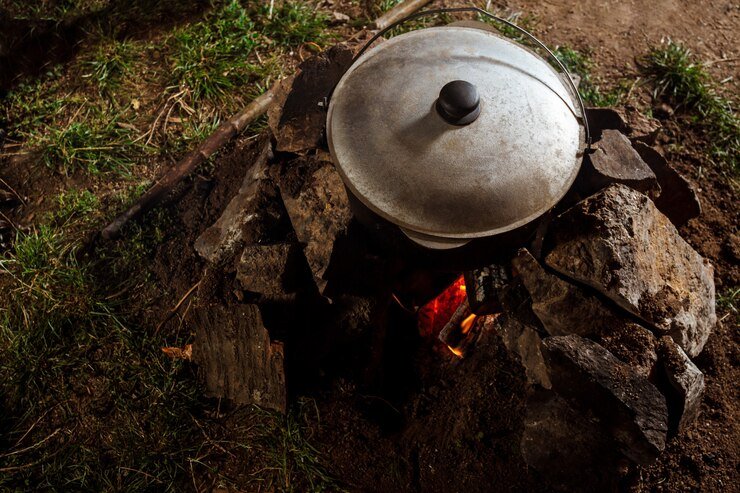The Pot That Brings People Together
Picture a chilly winter evening in a Japanese home. The table is set, and at the center sits a clay pot, steam gently rising from its lid. Family members gather around, each adding vegetables, tofu, or thin slices of meat to the bubbling broth inside. The pot isn’t just for cooking, it’s for sharing.
This is the donabe clay pot cooking tradition, a practice that has lasted for centuries in Japan. More than just cookware, the donabe has been a symbol of warmth, hospitality, and togetherness. Despite the rise of modern appliances—microwaves, rice cookers, and stainless-steel pans the donabe has survived, proving that some traditions are timeless.
Why This Topic Matters
Donabe clay pots aren’t just kitchen tools. They represent an entire way of cooking that values patience, community, and connection to the earth. While many cultures had clay pots, Japan elevated the donabe into something deeply cultural.
In an age when most of us prioritize speed, the donabe reminds us that slowing down creates better flavors and stronger relationships. Understanding this tradition isn’t just about food; it’s about reconnecting with values that modern life sometimes overlooks.
A Brief History of the Donabe
The word donabe literally means “clay pot” in Japanese (do = clay, nabe = pot). Archaeologists have traced the origins of clay cooking vessels in Japan back to the Jomon period (14,000–300 BCE), when people first used fire-hardened pottery for boiling food.
By the Edo period (1603–1868), donabe had become a staple in everyday kitchens. Families used it for hot pot dishes (nabe ryori), soups, rice, and stews. Towns like Iga in Mie Prefecture became famous for their high-quality clay, producing donabe pots that could withstand both direct flame and long cooking times.
Surprisingly, many modern donabe pots are still handcrafted in the same regions, using techniques that haven’t changed in hundreds of years.
How Donabe Clay Pot Cooking Works
At first glance, donabe may look simple, just a heavy clay pot with a lid. But its design makes it special:
-
Thick Clay Walls: Distribute heat evenly and retain warmth long after the flame is turned off.
-
Porous Material: Helps absorb broth flavors over time, making dishes richer the more you use the pot.
-
Versatility: Can sit directly on an open flame, unlike most other clay cookware.
Using a donabe is straightforward: place it on a gas stove or over charcoal, add broth and ingredients, and let it slowly cook while everyone at the table shares from it. It’s not just cooking, it’s communal dining.
Types of Donabe Pots
Not all donabe are the same. Over centuries, Japanese potters developed specialized designs:
-
Classic Donabe: Used for hot pot meals (shabu-shabu, sukiyaki, yosenabe).
-
Kamado Donabe: Designed for cooking fluffy rice, mimicking traditional wood-fired stoves.
-
Donabe Steamers: Equipped with inserts that allow vegetables, fish, or dumplings to steam.
-
Smoker Donabe: A modern adaptation that lets you smoke meats, fish, or cheese indoors.
Each variation highlights the adaptability of the donabe in Japanese cuisine.
Cultural Significance of Donabe Clay Pot Cooking
In Japan, food is more than sustenance; it’s a social ritual. Donabe dishes are at the heart of gatherings, especially during colder months. Sitting around a bubbling clay pot fosters intimacy. Everyone cooks together, eats together, and lingers long after the last bite.
In rural areas, donabe symbolized frugality and warmth, stretching simple ingredients into hearty meals. In urban settings, it became associated with hospitality and comfort food.
Even today, many Japanese families say a home-cooked donabe meal feels more “authentic” and grounding than anything made with modern gadgets.
Comparing Donabe with Modern Cookware
| Feature / Benefit | Donabe Clay Pot Cooking | Modern Cookware (Steel/Non-stick) |
|---|---|---|
| Heat Distribution | Slow, even, retains warmth | Heats quickly, cools fast |
| Flavor | Absorbs broth, deepens taste | Neutral, no flavor memory |
| Experience | Communal, dining at the table | Individual, kitchen-to-table style |
| Durability | Fragile if dropped | Long-lasting, less fragile |
| Cultural Value | Centuries of tradition | Purely functional |
Here’s what this really means: while modern cookware wins in speed and toughness, donabe wins in flavor and cultural depth.
My Experience with Donabe
I remember the first time I tried donabe cooking in a small Tokyo restaurant. The chef brought out a pot of bubbling broth, placing it on a burner at our table. As we added mushrooms, tofu, and thinly sliced beef, the aroma filled the room. Each bite tasted richer than the last.
Later, I bought a small donabe for myself. Cooking rice in it was a revelation—each grain was fluffier, with a hint of smoky earthiness you can’t get from an electric rice cooker. It took longer, but it felt more rewarding.
Expert Insights
According to Smithsonian Magazine, donabe cookware reflects Japan’s “slow food” culture, where time and ritual are just as important as taste. National Geographic highlights how towns like Iga have preserved clay pot-making traditions, treating donabe not just as tools but as cultural artifacts.
Even chefs outside Japan, such as those in Michelin-starred restaurants, have adopted donabe cooking. They note its ability to elevate flavors in rice, stews, and broths beyond what modern cookware can achieve.
Why Donabe Survived the Centuries
Many ancient kitchen tools disappeared once modern technology took over. But donabe endured. Why?
-
Flavor: The porous clay enhances taste over repeated use.
-
Simplicity: No wires, no buttons, just fire and clay.
-
Versatility: From rice to soups to stews, one pot can do it all.
-
Tradition: It represents family, warmth, and culture.
When you step back, it feels like donabe isn’t just about food. It’s about reminding us that sometimes the old ways are still the best.
FAQs: Donabe Clay Pot Cooking
Q1: Can you use a donabe on an electric stove?
Donabe is best suited for gas or open flame. Some modern versions are adapted for induction, but traditional ones may crack on electric stoves.
Q2: Does donabe need special care?
Yes. It should be seasoned before first use (boiling rice water inside) and allowed to dry completely after cooking.
Q3: What can you cook in a donabe?
Hot pots, rice, stews, soups, steamed vegetables, and even smoked dishes, depending on the type.
Q4: Is donabe safe for modern cooking?
Absolutely. As long as it’s lead-free and properly maintained, donabe is perfectly safe and healthy.
Final Thoughts: Clay, Fire, and Community
The donabe clay pot cooking tradition is proof that some tools outlast trends. While our kitchens fill with gadgets, this humble clay pot remains at the center of Japanese meals. It carries flavors, memories, and centuries of culture in every simmering broth.
Here’s what this really means: donabe survived not because it resisted change, but because it continues to offer something modern cookware can’t connect. Connection to flavor, to tradition, and most importantly, to each other.
So maybe the next time you’re cooking rice or stew, consider trying a donabe. You might find that what you create isn’t just a meal, but a piece of living history.



